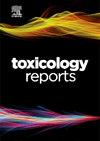Nanotherapeutic smart approaches for combating Alzheimer’s disease and overcoming existing obstacles: A novel eco-friendly green approach
Q1 Environmental Science
引用次数: 0
Abstract
The scientific community has united to raise awareness of Alzheimer's disease (AD) as a critical condition for future generations because recent predictions indicate that it will become common among the elderly within a few years. Nevertheless, the intricacies of the disease's progression demand exhaustive investigations to unravel its potential mechanisms. Only then can clinicians develop more efficacious therapeutic strategies. Cognitive impairment caused by amyloid aggregation, the development of hyperphosphorylated neurofibrillary tangles, and a malfunctioning cholinergic system are the hallmarks of AD. Even after the disease has started, brain tissue integrity may degenerate. The physiological characteristics of the highly selective blood-brain barrier and the electrostatic charge of the nanoporous extracellular matrix have long placed restrictions on the treatment of brain disorders. A prospective revolution in drug delivery for the treatment of AD is the use of nanomedicine. It depends on enhancing the way that medications are distributed pharmacokinetically throughout the central nervous system. Several types of nanoparticles (Nps) are available thanks to nanotechnology, and these Nps could target the brain and have a long half-life with few systemic side effects and motor problems. With the latest technological developments, scientists are working to develop unique approaches for the treatment of AD. To evaluate the prospective uses of medicinal plants, their components, and different nanomedicine techniques, it was determined that this literature study was necessary. To provide an overview of the various challenges and approaches related to using nanoparticles (NPs) to combat Alzheimer's disease (AD), this introductory review article was developed.
对抗阿尔茨海默病和克服现有障碍的纳米治疗智能方法:一种新颖的环保绿色方法
科学界已经联合起来提高人们对阿尔茨海默病(AD)的认识,因为最近的预测表明,在几年内,这种疾病将在老年人中变得普遍。然而,这种疾病发展的复杂性需要详尽的调查来揭示其潜在的机制。只有这样,临床医生才能制定出更有效的治疗策略。淀粉样蛋白聚集引起的认知障碍、过度磷酸化的神经原纤维缠结的发展以及胆碱能系统的功能障碍是阿尔茨海默病的标志。即使在疾病开始后,脑组织的完整性也可能退化。高选择性血脑屏障的生理特性和纳米多孔细胞外基质的静电电荷长期以来一直限制着脑部疾病的治疗。纳米药物的使用是治疗阿尔茨海默病的药物传递的一个有前景的革命。这取决于增强药物在整个中枢神经系统中的药代动力学分布方式。多亏了纳米技术,几种类型的纳米粒子(Nps)已经可用,这些Nps可以靶向大脑,并且具有较长的半衰期,几乎没有系统副作用和运动问题。随着最新技术的发展,科学家们正在努力开发治疗阿尔茨海默病的独特方法。为了评估药用植物及其成分和不同纳米医学技术的潜在用途,确定本文献研究是必要的。为了提供与使用纳米颗粒(NPs)对抗阿尔茨海默病(AD)相关的各种挑战和方法的概述,这篇介绍性综述文章被开发出来。
本文章由计算机程序翻译,如有差异,请以英文原文为准。
求助全文
约1分钟内获得全文
求助全文
来源期刊

Toxicology Reports
Environmental Science-Health, Toxicology and Mutagenesis
CiteScore
7.60
自引率
0.00%
发文量
228
审稿时长
11 weeks
 求助内容:
求助内容: 应助结果提醒方式:
应助结果提醒方式:


